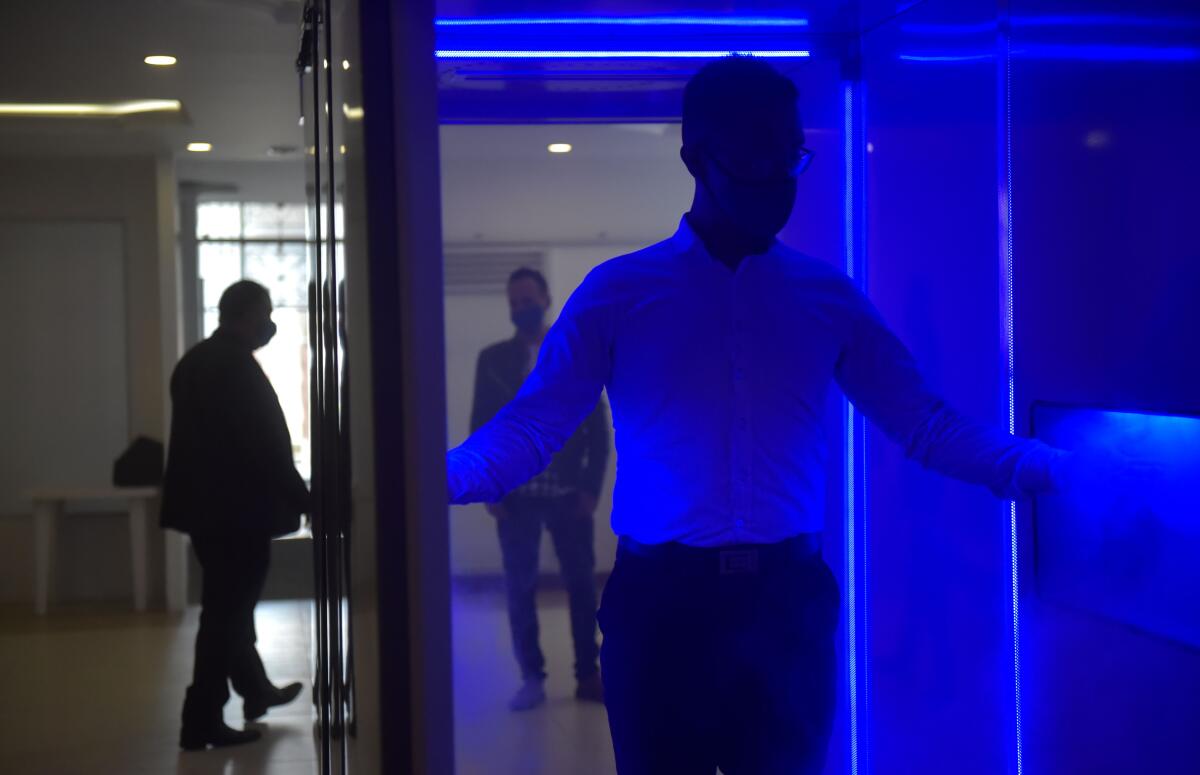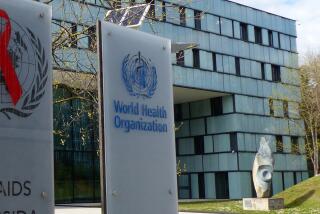Scientists call for sweeping change in building design to reduce airborne diseases like COVID-19

- Share via
SEATTLE — The failure to contain the COVID-19 pandemic has been blamed on ill-preparedness, poor leadership and political squabbling.
A group of scientists has identified another culprit: buildings.
In a paper published Thursday in the journal Science, 39 experts in various fields called for a “paradigm shift” in the design of buildings and their ventilation systems, a safety upgrade on par with the 19th century introduction of clean water supplies and centralized sewage systems.
The authors of the report have been at the forefront of a campaign to convince international health authorities that the coronavirus spreads through exhaled microscopic particles known as aerosols that can float in the air for hours — and that the risk is greatest indoors.
They wrote that with the exception of hospitals, few large buildings have been designed to limit the spread of airborne pathogens, despite the risk of fueling widespread illnesses and their related economic losses. Office towers and other commercial buildings are typically engineered for energy savings and odor and temperature control, but not public health.
The scientists envision futuristic buildings with systems that could detect a crowd gathering in a room and immediately adjust the ventilation to increase air turnover. Monitors would display air quality measurements in real time.
Lidia Morawska, the lead author of the paper and a physicist at the Queensland University of Technology in Australia, said in an interview that many of the technologies already exist but that they have not been combined on a large scale in a targeted effort to reduce the spread of disease.
“Think of how many cases during this pandemic could have been prevented if this was taken seriously,” she said.
Think of how many cases during this pandemic could have been prevented if this was taken seriously.
— Lidia Morawska, a physicist at the Queensland University of Technology
The paper cited estimates suggesting that the systems would increase the construction cost of a typical building by less than 1% — a price that the authors said would be more than offset by preventing the spread of influenza and other costly illnesses.
“There needs to be a shift in the perception that we cannot afford the cost of control, because economic costs of infections can be massive,” the paper said.
Still, such ideas are likely to be met with resistance from building developers, owners and operators. One potential problem is that the increased power needed to heat and cool larger amounts of air and to push it through high-grade filters with bigger fans would conflict with energy-saving mandates introduced in recent years to slow climate change.
“It’s always a fight between these two groups, one wanting energy efficiency and the other wanting more healthy indoor air quality,” said John Zhai, a professor of architectural engineering at the University of Colorado in Boulder, who was not involved in the Science paper.
“But the pandemic makes this a good time to consider how to balance those needs, and if we don’t do anything now, people will just do business as usual.”
Buildings could be designed to achieve both aims if architects and engineers gave them the ability to switch back and forth between functions, said Liangzhu “Leon” Wang, a professor of building, civil and environmental engineering at Concordia University in Montreal, who was not a coauthor either.
Despite a statewide mood of optimism, about 57 Californians are still succumbing to the novel coronavirus each day.
Morawska said a failure by experts at the World Health Organization and the U.S. Centers for Disease Control and Prevention to declare early in the pandemic that the coronavirus was an airborne pathogen led to muddled public health policies.
Since the 1800s, scientists have swung between accepting and rejecting findings that respiratory diseases can spread through the air, according to a recent paper by researchers including Linsey Marr, a Virginia Tech environmental engineer who also helped write the paper in Science.
Marr said health authorities have required proponents of the theory of transmission via aerosols to meet a higher standard of proof, while accepting spread by large droplets without equivalent evidence.
“I suspect that inhalation of aerosols is the dominant route of transmission for SARS-CoV-2 and other respiratory viruses, but have been afraid to say so because I have been ignored or ridiculed in the past,” she tweeted on May 7.
Morawska said she and her scientific allies wrote to the WHO and national public health authorities on April 1, 2020, challenging statements by the international agency’s director-general, Tedros Adhanom Ghebreyesus, who had maintained that the coronavirus was not airborne.
In July, after more than half a million people had died in the pandemic, the group followed up with an open letter to the WHO that was signed by 239 experts from 32 countries. In the letter — which was published in the journal Clinical Infectious Diseases after being rejected by Nature and the Lancet — they appealed for recognition of the potential for transmission of the virus through aerosols and urged preventive measures.
More than 200 researchers worldwide sign an open letter saying current guidance ignores evidence that the coronavirus readily spreads on microscopic particles known as aerosols that can hang in the air for long periods and float dozens of feet.
Despite mounting evidence in studies of superspreading events, the WHO and the CDC resisted the theory, only gradually changing their official guidance to acknowledge aerosol transmission of the virus.
Morawska said the WHO still doesn’t go far enough, continuing to emphasize transmission occurring within one meter, or about three feet.
“There’s nothing magical about one meter,” she said. “It’s a continuum with the concentration of the virus the highest closest to the source.”
The Science paper noted that the WHO has some health-based indoor air quality guidelines for limiting toxic compounds such as benzene and carbon monoxide, but said the agency had no standards for mitigating respiratory viruses or bacteria inside buildings.
Building owners who already face a proliferating list of requirements — including carbon-neutrality deadlines and installation of emergency radio systems, staircase lights and glass lobby doors for fire control — may resist another set of mandates.
Rod Kauffman, president of the Seattle-area chapter of the national Building Owners and Managers Assn., said that some members who are preparing for workers to begin returning to offices are installing systems such as devices that use ultraviolet light to remove pathogens.
“We’re all looking forward to being able to do as much as we can,” he said. “But there are practical limits to what you can do as a building owner before you start having to raise the rates for your tenants.”
More to Read
Sign up for Essential California
The most important California stories and recommendations in your inbox every morning.
You may occasionally receive promotional content from the Los Angeles Times.












